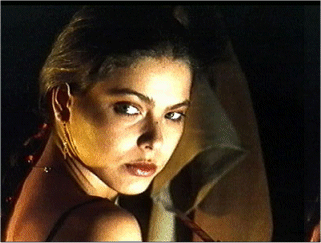Check out the first part of a video essay series on Steven Spielberg. From Matt Zoller Seitz, Ali Arikan, and Serena Bramble.
Million Dollar Movie
He adored New York City. He idolised it all out of proportion.
Great shot of Yankee Stadium in this sequence.
Million Dollar Movie
Sunday and Monday on American Masters:
Watch Woody Allen: A Documentary on PBS. See more from AMERICAN MASTERS.
Million Dollar Movie
Adaptations…
From The Age of Movies, here’s Pauline Kael on The Iceman Cometh (1973):

The Iceman Cometh is a great, heavy, simplistic, mechanical, beautiful play. It is not the Eugene O’Neill masterpiece that Long Day’s Journey Into Night, the finest work of the American theater, is, but it is masterpiece enough–perhaps the greatest thesis play of the American theater–and it has been given a straightforward, faithful production in handsome dark-toned color in the subscription series called the American Film Theatre. A filmed play like this doesn’t offer the sensual excitement that movies can offer, but you don’t go to it for that. You go to it for O’Neill’s crude, prosaic virtuosity, which is also pure American poetry, and, as with most filmed dramas, if you miss the “presence” of the actors, you gain from seeing it performed by the sort of cast that rarely gathers in a theater. John Frankenheimer directly fluently and unobtrusively, without destroying the conventions of the play. The dialogue is like a ball being passed from one actor to the next; whenever possible (when the speakers are not too far apart), the camera pans smoothly from one to another. We lose some of the ensemble work we’d get from a live performance, but we gain a closeup view that allows us to see and grasp each detail. The play here is less broad than it would be on the stage, and Frankenheimer wisely doesn’t aim for laughs at the characters’ expense (even though that O’Neill may have intended), because the people are close to us. The actors become close to us in another way. Actors who have been starved for a good part get a chance to stretch and renew themselves. In some cases, we’ve been seeing them for years doing the little thing passes for acting on TV and in bad movies, and their performances here are a revelation; in a sense, the actors who go straight for the occasion give the lie to the play’s demonstration that bums who live on guilt for what they don’t do can’t go back and do it.
And The Dead (1987):
The announcement that John Huston was making a movie of James Joyce’s “The Dead” raised the question “Why? What could images do that Joyce’s words hadn’t? And wasn’t Huston pitting himself against a master who, though he was only twenty-five when he wrote the story, had given it full form? (Or nearly full–Joyce’s language gains from being read aloud.) It turns out that those who love the story needn’t have worried. Huston directed teh movie, at eighty, from a wheelchair, jumping up to look through the camera, with oxygen tubes trailing from his nose to a portable generator; most the time, he had to watch the actors on a video monitor outside the set and use a microphone to speak to the crew. Yet he went into dramatic areas that he’d never gone into before–funny, warm family scenes that might be thought completely out of his range. He seems to have brought the understanding of Joyce’s ribald humor which he gained from his knowledge of Ulysses into his earlier work; the minor characters who are shadowy on the page now have a Joycean vividness. Huston has knocked the academicism out of them and developed the undeveloped parts of the story. He’s given it a marvelous filigree that enriches the social life. And he’s done it all in a mood of tranquil exuberance, as if moviemaking had become natural to him, easier than breathing.
Million Dollar Movie
From “The Age of Movies,” here’s P. Kael on History of the World, Part I:
When I saw History, there were hisses and walkouts during this number, and the film has been attacked as a disgrace by reviewers in the press and on TV. I bet nobody hissed or walked out on Candide. When Prince and Bernstein do it, it’s culture; when Brooks does it, there’s a chorus of voices saying, “He has gone too far this time.” Earlier in the film, the dancer Gregory Hines, who makes a breezy film debut as Comicus’ Ethiopian pal, Josephus, tries to convince the slavers who are sending him to the circus to be eaten by lions that he’s not a Christian but a Jew. With his loose-limbed body–his legs seem to be on hinges–he does a mock-Jewish dance, and then a shim-sham, and the racial humor didn’t appear to bother the audience. But during the Inquisition, when nuns toss off their habits, and a giant torture wheel to which pious Jews are attached is spun in a game of chance, there were mutterings of disapproval. Yet it’s Brooks’s audacity–his treating cruelty and pain as a crazy joke, and doing it in a low-comedy context–that gives History the kick that was missing from his last few films. The Inquisition is presented as a paranoid fantasy, with Jews as the only victims, and when Torquemada whacks the knees of gray-bearded old men imprisoned in stocks–using them as a xylophone–you may gasp. But either you get stuck thinking about the “bad taste” or you let yourself laugh at the obscenity in the humor, as you do at Bunuel’s perverse dirty jokes. The offensive material is a springboard to a less sentimental kind of comedy.
If Mel Brooks doesn’t go “too far,” he’s nowhere–he’s mild and mushy. It’s his maniacal, exuberant compulsion to flaunt show-biz Jewishness that makes him an uncontrollable original. At his best, he is to being Jewish what Richard Pryor is to being black: wildly in love with the joke of it, obsessed and inspired by the joke of it. What History needs is more musical numbers with the show-biz surreal satire of the Inquistion section; it’s the kind of satire that makes the Marx Brothers’ Duck Soup a classic farce. Brooks goes wrong when he pulls back to innocuous loveability–when he has Gregory Hines say to him, “You’re the first white man I even considered liking.” (Now, if that had been “the first Jews…”) Hines’ dancing–the movie could have used more of it–deserves better than a suck-up line.
When Brooks has a hot streak on a TV talk show, you can see his mental process at work, and amazing things just pop out of his mouth. He can’t get that rhythm going on the screen with prepared gags. Some movie directors can give their material that surprise. Altman has often done it, and in Hi, Mom! DePalma did it, with a highly inflammatory race-relations subject. But Brooks isn’t a great director–far from it. He’s a great personality though, and he moves wonderfully; his dancing in his Torquemada robes is right up there with Groucho’s lope. Wearing a little mustache and with his lips puckered, Brooks as Louis XVI bears a startling resemblance to Chaplin in his Monsieur Verdoux period. I kept waiting for him to do something with this resemblance, but he didn’t. Was he unaware of it? Lecherous Louis did, however, make me understand why women at the French court wore those panniers that puffed out the sides of their skirts; we see those ballooning bottoms through his eyes. (Brooks may be wasting his talent by not appearing in other directors’ movies while he’s preparing his own.) As a director-star, he has the chance to go on pushing out the boundaries of screen comedy, because, despite the disapproving voices in the press and on TV, he can probably get away with it. Like Pryor, he’s a cutie.
Too bad for us, Mel’s movies never got better, but he sure did score a hit with the play version of The Producers.
Million Dollar Movie
More P. Kael from “The Age of Movies. ”
From the essay, “Fear of Movies” (September 25, 1978):
In his new book The Films in My Life, Francois Truffaut writes, “I demand that a film express either the joy of making cinema or the agony of making cinema. I am not all interested in anything in between; I am not interested in all those films that do not pulse.” Truffaut’s dictum may exclude films that some of us enjoy. You couldn’t claim that National Lampoon’s Animal House expresses either the joy or the agony of making cinema. It’s like the deliberately dumb college-football comedies of the thirties–the ones with Joan Davis or Martha Ray–only more so; it’s a growly, rambunctious cartoon, and its id anarchy triumphs over the wet-fuse pacing, the botchy lighting, and the many other ineptitudes. In its own half-flubbed way, it has a style. And you don’t go to a film like Animal House for cinema, you go for roughhousing disreputability; it makes you laugh by restoring you to the slobby infant in yourself. (If it were more artistic, it couldn’t do that.)
But that sort of movie is a special case. Essentially, I agree with Truffaut. I can enjoy movies that don’t have that moviemaking fever in them, but it’s enjoyment on a different level, without the special aphrodisia of movies–the kinetic responsiveness, the all-out submission to pleasure. That “pulse” leaves you with all your senses quickened. When you see a movie such as Convoy, which has this vibrancy and yet doesn’t hold together, you still feel clearheaded. But when you’ve seen a series of movies without it, whether proficient soft-core porn like The Deep or klutzburgers like Grease, you feel poleaxed by apathy. If a movie doesn’t “pulse”–if the director isn’t talented, and if he doesn’t become fervently obsessed with the possibilities that subject offers him to explore moviemaking itself–it’s dead and it deadens you. Your heart goes cold. The world is a dishrag. (Isn’t the same thing true for a novel, a piece of music, a painting?)
The pressing against the bounds of the medium doesn’t necessarily result in a good movie (John Boorman’s debauch Exorcist II: The Heretic is proof of that), but it generally results in a live one–a movie there’s some reason to see–and it’s the only way great movies get made…there’s enough visual magic in [Exorcist II] for a dozen good movies; what the picture lacks is judgment–the first casualty of the moviemaking obsession.
…There’s no way I could make the case that Animal House is a better picture than Heaven Can Wait, yet on some sort of emotional-aesthetic level I prefer it. One returns you to the slobbiness of infancy, the other to the security of childhood, and I’d rather stand with the slobs.
I love this.
Million Dollar Movie
From “The Age of Movies: Selected Writings of Pauline Kael,” here’s Kael on Robert De Niro.
First, in Mean Streets:
While an actor like Jeff Bridges in The Last American Hero hits the true note, De Niro here hits the far-out, flamboyant one and makes his own truth. He’s a bravura actor, and those who have registered him only as the grinning, tobacco-chewing dolt of that hunk of inept whimsey Bang the Drum Slowly will be unprepared for his volatile performance. De Niro does something like what Dustin Hoffman was doing in Midnight Cowboy, but wilder; this kid doesn’t just act–he takes off into the vapors. De Niro is so intensely appealing that it might be easy to overlook Harvey Keitel’s work as Charlie. But Keitel makes De Niro’s triumph possible; Johnny Boy can bounce off Charlie’s anxious, furious admiration.
The Godfather Part II:
Brando is not on the screen this time, but he persists in his sons, Fredo and Michael, and Brando’s character is exteneded by our seeing how it was formed. As Vito, Robert De Niro amply convinces one that he has it in him to become the old man that Brando was. It’s not that he looks exactly like Brando but he has Brando’s wary woul, and so we can easily imagine the body changing with the years. It is much like seeing a photograph of one’s own dead father when he was a strapping young man; the burning spirit we see in his face spooks us, because of our knowledge of what he was at the end. In De Niro’s case, the young man’s face is fired by a secret pride. His gesture as he refuses the gift of a box of groceries is beautifully expressive and has the added wonder of suggesting Brando, and not from the outside but from the inside. When De Niro closes his eyes to blot out something insupportable, the reflex is like a presentiment of the old man’s reflexes. There is such a continuity of soul between the child on the ship, De Niro’s slight, ironic smile as a coward landlord tries to appease him, and Brando, the old man who died happy in the sun, that although Vito is a subsidiary character in terms of actual time on the screen, this second film, like the first, is imbued with his presence.
…De Niro’s performance is so subtle that when he speaks in the Sicilian dialect he learned for the role he speaks easily, but he is cautious in English and speaks very clearly and precisely. For a man of Vito’s character who doesn’t know the language well, precision is important–sloppy talk would be unthinkable. Like Brando’s Vito, De Niro’s has a reserve that can never be breached.
Taxi Driver:
Robert De Niro is in almost every frame: thin-faced, as handsome as Robert Taylor one moment and cagey, ferrety, like Cagney, the next–and not just looking at the people he’s talking to but spying on them. As Travis, De Niro has none of the pleasant courtliness of his Vito Corleone in The Godfather Part II. Vito held himself proudly, in control of his violence; he was a leader. Travis is danger in a different, cumulative way. His tense face folds in a yokel’s grin and he looks almost like an idiot. Or he sits in his room vacantly watching the bright-eyed young faces on the TV and with his foot he slowly rocks the set back and then over. The exacerbation of his desire for vengeance shows in his numbness, yet part of the horror implicit in this movie is how easily he passes. The anonymity of the city soaks up one more invisible man; he could be legion.
…Some actors are said to be empty vessels who are filled by the roles they play, but that’s not what appears to be happening here with De Niro. He’s gone the other way. He’s used his emptiness–he’s reached down into his own anomie. Only Brando has done this kind of plunging, and De Niro’s performance has something of the undistanced intensity that Brando’s had in Last Tango. In its own way, this movie, too, has an erotic aura. There is practically no sex in it, but no sex can be as disturbing as sex. And that’s what it’s about: the absence of sex–bottled-up, impacted energy and emotion, with a blood-splattering release. The fact that we experience Travis’s need for an explosion viscerally, and that the explosion itself has the quality of consummation, makes Taxi Driver one of the few truly modern horror films.
And Raging Bull:
As Jake La Motta, the former middleweight boxing champ, in Raging Bull, Robert De Niro wears scar tissue and a big, bent nose that deform his face. It’s a miracle that he didn’t grown them–he grew everything else. He developed a thick-muscled neck and a fighter’s body, for the scenes of the broken, drunken La Motta he put on so much weight that he seems to have sunk in the fat with hardly a trace of himself left. What De Niro does in this picture isn’t acting, exactly. I’m not sure what it is. Though it may at some level be awesome, it definitely isn’t pleasurable. De Niro seems to have emptied himself out to become the part he’s playing and then not got enough material to refill himself with: his La Motta is a swollen puppet with only bits and pieces of a character inside, and some semi-religious, semi-abstract concepts of guilt. He has so little expressive spark that what I found myself thinking about wasn’t La Motta or the movie but the metamorphosis of De Niro. His appearance–with his head flattened out and widened by fat–is far more shocking that if he were artificially padded.
Raging Bull isn’t just a biography of a genre; it’s also about movies and about violence, it’s about gritty visual rhythm, it’s about Brando, it’s about the two Godfather pictures–it’s about Scorsese and De Niro’s trying to top what they’ve done and what everybody else has done. When De Niro and Liza Minnelli began to argue in Scorsese’s New York, New York, you knew they were going to go from yelling to hitting, because they had no other way to escalate the tension. Here we get more of these actors’ battles; they’re between Jake and Joey, and between Jake and Vickie. Listening to Jake and Joey go at each other, like the macho clowns in Cassavetes movies, I know I’m supposed to be responding to a powerful, ironic realism, but I just feel trapped. Jake says, “You dumb fuck,” and Joey says, “You dumb fuck,” and they repeat it and repeat it. And I think, What am I doing here watching these two dumb fucks?
Bronx Banter Interview: Sanford Schwartz
“The Age of Movies: Selected Writings of Pauline Kael,” edited by Sanford Schwartz is a new release from the Library of America and it’s been getting a lot of press along with Brian Kellow’s Kael biography. I’m going to blog about P. Kael, who is one of my favorite writers, all week and will include all the links fit to click.
For starters, here’s a recent conversation I had with Sanford Schwartz.
Check it out:
Bronx Banter: What was your approach in selecting the material for this book? My first impression was that it seemed thin, but then I checked and it is almost 800 pages, anything but thin. Then again, I grew up reading Kael and have all of her books. Is the ideal reader for this book someone who is unfamiliar with her work?
Sanford Schwartz: My first aim in selecting Pauline Kael pieces was to give the range of her thinking and sensibility. As a kid of shadow story, I wanted the selections to give a rough sense of movie history during the years she wrote. I wanted there to be representative pieces on the actors and directors who meant most to her. So there are a number of reviews on Altman, Godard, Scorsese, and so forth. I hoped that the anthology would engage people who already knew her—but unlike you didn’t collect all her books over the years—and also people who, in their twenties and thirties, don’t know who she is. It is always a surprise to run into people who have never heard of her, and I have found that most young people haven’t.
BB. Kael was close to fifty when she started reviewing movies for the New Yorker though she’d been writing for some time. How do you think this influenced her voice as a writer, as opposed to other critics who get their start much earlier?
SS: I’m not sure that it meant a lot. Her having waited so long and absorbed so many movies along the way obviously couldn’t have hurt when it came to writing with authority and conviction. But that certainty was evident in her letters from the late 1930s and early 1940s, when she was in her early twenties—except that her subject was still unclear to her. And it was fortuitous, her coming into the field when she did—an art form was being revitalized.
BB: What did Kael bring to movie criticism in the 1960s and ’70s that set her apart from her contemporaries?
SS: Kael made reading movie reviews a more intimate and personal experience than it had ever been before. Little criticism of any kind conveyed a comparable sense of there being such a powerful, funny, opinionated, scarily shrewd, and common sensical voice there, talking to you. You wanted to know what she thought about everything. You don’t feel this with most journalists, whether they are reviewing an art of doing a political column.
BB: One of the quirks that Kael was famous for was only watching a movie once. She’s been criticized for that over the years, that it suggests a lack of reflection or the possibility that a work of art can change for you. What is it about watching a movie only one time that informed the way she wrote about it?
SS: First off, it should be noted that there were times when she saw a movie more than once. I saw a number of movies with her when it was her second time. But then it was usually because she was checking something. I think she joked about falling asleep during Bresson’s “Diary of a Country Priest” both times she saw it. How many times she saw a movie was conditioned, actually, by her generally tight writing schedule; she usually didn’t have the time to see a movie twice. But the deeper point with this issue concerns the importance of instinct for her. She believed our truest response to a movie (or any art) was our first one, and she wanted to catch that. It was also a matter of temperament. She had on-the-spot judgments about many things. That was how she operated. Movies for her, even the great, complex ones, were about the senses in a way that books were not, and in seeing a movie once and trying to recapture its immediate impact she was, in her thinking, being true to the experience it offered.
BB. Did you re-watch any of the movies whose reviews you included in the collection?
SS: I saw some again, and initially I thought it would be good to re-see many of them. But my sense if that going back to films I loved years ago is hazardous. You re-see Truffaut, Satyajit Ray, or “The Leopard” and part of you must confront ways that the movie, and you, have changed—and altogether the event is more about time than the movie. How movies age is an interesting topic. Kael talked about it in “Movies and Television.”
BB: You’ve included her most famous reviews, ones she was chided about for over-praising like “The Last Tango in Paris,” “Nashville,” and to a lesser extent, “Casualties of War.” How do you think her takes on those movies stand up?
SS: I can’t say how her reviews of those movies hold up because I haven’t seen them recently. My hunch is that she did go overboard on them. I probably felt that then. But of course the reviews had to be in any anthology of her work. They were major pieces for her. They are statements of her belief.
BB: Kael has been ridiculed for her enthusiasm for those movies, but her take on other “classics” of that time period, particularly two “Godfather” movies or “Mean Streets” or “Shampoo” seem spot on. Are there any particular movies that she loved where you feel that her writing is especially sharp?
SS: I wasn’t that interested in whether she was, as you say about some of her reviews, “spot on.” In reviewing an art, reasoning and descriptions count for much more than opinion. As to what I think she was especially sharp on, I hope “The Age of Movies” provides an answer. Are there many more pieces that might have gone in? For sure.
BB: I like that you’ve included her major essays like “Trash, Art and the Movies,” “Why Are Movies So Bad? or The Numbers,” and the long one on Cary Grant, “The Man From Dream City.” And especially an early on, “Movies, the Desperate Art.” But you did not include her celebrated essay on “Citizen Kane.” Is that because it was just too long or because you feel it doesn’t hold up as representative of her talent?
SS: No, the Kane article, as I say in the Introduction, is too long to be included.
BB: One of Kael’s first memorable articles was “Circles and Squares,” a harsh take on fellow critic Andrew Sarris’ ideas about the auteur theory. Why did you not include that one?
SS: I didn’t include the Sarris essay because it is too long for the points it makes. It would have hogged space from livelier writing—writing that meant more to Kael. There are good words in it on what criticism meant for her. If I had excerpts in the anthology I probably would have excerpted those passages. I felt also that readers for whom “auteur” issues mater would already know Kael’s piece, whereas for the wider audience that she wrote for at The New Yorker, and for whom “The Age of Movies” is intended, her deflating this theory—it is really a set of opinions—is not a very engaging issue. And while I think she nails Sarris and the whole approach, she doesn’t do it in a way that opens up the topic to the general reader. Unless you are already familiar with the auteur line, her essay is rather confusing, especially at the beginning. It isn’t an essay that had much long-term meaning for her; she never could take that stuff seriously.
BB: Kael’s review of the documentary, “Shoah,” was famous because she panned it but it’s not here.
SS: I didn’t have a powerful reason to skip the “Shoah” review. Probably, it was a matter of space and also the sense that the reasoning and attitude on display there was already clear from other articles. It is certainly a strong one, though.
BB: During the ’70s, Kael shared her position writing “The Current Cinema” at the New Yorker with Penelope Gilliatt. As a result, there are some classics from that time that she never reviewed properly like “Annie Hall,” “Dog Day Afternoon” (though she does mention this one in a notes column), and maybe especially, “Apocalypse Now.” Were there any movies that you missed her reviewing?
SS: Even with her half-year schedule in the beginning, I believe she managed to encompass the major films of her era (but a movie historian might have another view of this). If a movie was taken seriously or touched hot issues for people—and it came out when she was off—she generally managed to find a way to her her verdict in somewhere. The long articles she periodically wrote during the time she was off let her do just that. She used a piece ostensibly about actors to acknowledge “Jaws” and she let people know where she stood on “2001” in “Trash, Art, and the Movies.”
BB: Kael had her favorites—Peckinpah and DePalma, to name just two—and those who she was famous for blasting, like Kubrick and Woody Allen. But she actually took each movie as it came, and I like that you’ve included “Lolita,” which she adored and as well as “A Clockwork Orange,” which she hated. Same goes for the early Scorsese hits, “Mean Streets,” and “Taxi Driver,” again, which she loved, and “Raging Bull,” which was the first in a long line of his movies that turned her off. Even though she was famous for her prejudices do you feel that she always gave a new movie an equal chance?
SS: Oh, yes. That is one reason I included her review of Bergman’s “Shame.” The piece shows her wrestling with the fact that a director with whom she was often at odds made a movie she had to call a masterpiece. She could always say when someone she admired—Altman, Godard, Bertolucci, Huston, even Renoir—came out flat. Her subject was the film at hand, not someone’s reputation or the credit they might have built up. She didn’t much like Robert Duvall, but after she saw “The Apostle,” which he directed and wrote as well as starred in, she said something like, “You’ve got to hand it to the bastard.”
BB: Kael once said that she never wrote a memoir because, “I think I have” in her reviews. She brought her life’s experience to her reviews, from what she knew about music and books and the theater, but also from what she knew about being a mother, having her heart broken in relationships, everything. Do you think you the story of her life can be found in her work?
SS: Yes, if the story of her life is constituted by her awareness and judgments. I don’t think she was the kind of artist whose life experience mirror or can be seen as a counterpoint to their work. For Agee and Farber, yes; their movie reviews tell us things about each man’s total contribution that we might not know otherwise. Kael, though, put most of what counted in her life in her reviews.
BB: She also once said “In movies, judgment is often not so important in a critic as responsiveness to what a movie feels like, and where it’s heading and what its vision is.” She was very tuned in to the reaction movies had on audiences, especially during her heyday in the early ’70s. Was there any other critic during that time, or any other time, that was as invested in how movies were received by popular culture and what it all meant?
SS: I believe you need a movie historian to answer this one. My feeling is that she got more of the ramifications of movies—their relation to the wider culture and society in general—than most film writers.
BB: This collection is spare toward the last 10 years of her career. Is that because the cultural moment of the movies had passed by the mid ’80s or because you were running out of room? Even though the pieces in her final two collections, “Hooked,” and particularly, “Movie Love,” are terse compared with her earlier writing, I think they had a lovely, compact quality. Were there any reviews that were hard for you not to include?
SS: Kael herself said that her strongest collections were those that covered the films of the 1970s. The movies were richer then. They brought out more of her. And she was first luxuriating in all the space The New Yorker gave her. It is possible that if she had first started reviewing in 1980 her pieces might have been longer and more nuances—even considering the quality of the movies. As it was, by the mid-1980s she had already put forth in some detail her aesthetic and social positions. I agree with you, though, about the “lovely, compact quality” of her reviews of the eighties.
BB: I recall Kael once writing with admiration for the discipline it took Altman to achieve a style that appeared casual and loose. I often think about that when I consider her writing—it is conversational but don’t you think it must have taken a lot of discipline to achieve that effect?
SS: Kael was almost always writing with a deadline, so the words had to come fast, and by nature she was suited to spilling her feelings. But she had to do a lot of work to get the reviews in shape. She could be making substantive changes right to the last minute.
“The Age of Movies” is out now and you can order it here.
As a follow-up to my conversation with Schwartz, I dipped into my library for more Kael and found this in “Afterglow: A Last Conversation with Pauline Kael,” by Francis Davis:
Well, the auteur theory originally meant something quite different from what people understand it be mean now. What it originally said was that a director conferred value upon a film—that if a director was an auteur, all of his films were great. I think the public never understood that, and neither did most of the press. It was an untenable theory, and it fell from sight. It’s now taken to mean that we should pay attention to who directed a movie, because a director is vital to a film, and of course this is true. But it’s something that everybody has always known. I mean, everybody knew that Howard Hawks was terrific. We went to see “To Have and Have Not” and “The Big Sleep” the day they opened, and there was an excitement in the theater, because we all knew that these movies were special. They were smart, and we loved the work of smart directors, because lots of movies were so dumb…But the auteurists considered all of his movies to be wonderful by definition, because he was an auteur. It reached a point where they were acclaiming the later movies of directors who had ceased doing good work years earlier. Hitchcock’s later movies were acclaimed, and they were stinkers—terrible movies. And many routine action movies were praised because they were the work of certain directors.
It’s sometimes discouraging to see of a director’s movies, because there’s so much repetition. The auteurists took this to be a sign of a director’s artistry, that you could recognize his movies. But for all of a director’s movies to be alike in some essential way can also be a sign that he’s a hack.
And this on Andrew Sarris:
We both loved movies. We had that in common, and I enjoy reading him as I enjoy reading very few critics. He has genuine reactions to movies, and many critics don’t. He picks things up and points things out…The big difference between us is that our taste in movies is so radically different. He really likes romantic, classically structured movies. He had very conservative tastes in movies; he didn’t love the farout stuff that I loved. He’s a man who likes movies like “Waterloo Bridge,” movies that drive me crazy with impatience. It’s funny that he should have been at the Voice, and the voice of an underground paper. I think I would have been much more suitable to the Voice, yet for years I got dumped on brutally by the paper. That always amazed me, because I thought, I’m praising movies you should love, so what’s going on here? He and I were at the wrong places—it’s one of those flukes of movie history.
Also this on eroticism in movies and not being able to review “Deep Throat” for the New Yorker:
It wasn’t a good movie. But I very badly wanted to write about it, because for all that was being written about it, nobody was really dealing with what was on the screen. I think half of the reason that people become interested in movies in the first place is sex and dating and everything connected with eroticism on the screen. And I felt that not to deal with all of that in its most naked form was to shirk part of what’s involved in being a movie critic.
I’d love to have written about more eroticism in the movies. I think it’s a great subject, and I dealt with it a little bit in my reviews of “Last Tango in Paris,” “Get Out Your Handkerchiefs,” and a few other movies. Bertrand Blier I loved writing about, because he dealt so much in sexual areas. But it was tough to write about it all with [New Yorker editor, William] Shawn. I had a real tough time with him when I wrote about “Tales of Ordinary Madness,” The Marco Ferreri version of Charles Bukowski, about a girl who’s virtually a mermaid, with Ben Gazzara as the Bukowski, more or less. It’s an amazing movie, with some scenes that are quite erotic. I had to put up a terrible fight to get it in. Shawn wanted to know if the critics for other magazines were covering it. I said that shouldn’t be our standard for what we covered at The New Yorker. But it was hard to convince Shawn that I wasn’t pulling some sort of swindle by sneaking material into the magazine that he felt didn’t belong there. He felt he was holding the line against barbarians, and to some degree I was a barbarian.
He made it very hard to write about certain aspects of movies. Nobody, really, has done a very good job of writing on a sustained level about the way movies affect people erotically, and about the fact that they became popular because they’re a dating game. People love movies that reason, because they excite them sexually. They go to them on dates, and they go to learn more about how to behave. I never got a real crack at writing about that.
Another terrific volume for Kael nerds is “Conversations with Pauline Kael”.
From an interview with Sam Staggs in Mandate (May 1983):
Mandate: Why do you hit so many nerves among the common readers? Why do you stir up such antagonism as well as such passionate devotion?
Kael: In my writing, I was trying to get at what I actually responded to at the movies, and I couldn’t do in formal, scholarly language. I worked to loosen my style—to get away from the term-paper pomposity that we learn at college. I wanted the sentences to breathe, to have the sound of a human voice. I began, for example, to interject remarks—interrupting a train of thought, just as we do when we talk, and then picking it up again. And when I began to feel the freedom to write as easily as I spoke, the writing itself became pleasurable.
Maybe part of the resentment I stir up among critics who suffer when they write is that they can tell I’m having a good time. My guess is that just as my slangy colloquial style appeals to some readers because it is sometimes enables me to get right at what I think the emotional substance of a movie is, it turns off other readers, who prefer more literary, distanced criticism. For example, I’m frequently disparaged as ‘opinionated’—I think what this comes down to is that often I don’t share in the consensus that builds up on certain movies. Sometimes, it builds up even before the critics have seen a picture, as it did on “Sophie’s Choice”—I suspect that a lot of readers are snowed by big themes and advance articles in the New York Times. And then, if they read me making fun of the picture, they’re outraged and think I’m irresponsible, and especially so because I don’t couch my review in the language that has come to be equated with ‘objectivity.’
And from a Q&A by Marc Smirnoff in the Oxford American (Spring 1992) after Kael had retired from the New Yorker:
Q: Is a person lucky to be a movie critic?
Kael: It is really a wonderfully exciting field to write about when the movies are good. When they’re not good, it’s to despair. The really bad movies you can write about with some passion and anger. It’s the mediocre ones that wear you down. They’re disgusting to write about because you can feel yourself slipping into the same mediocrity and stupidity. And you feel you’re boring the readers and yourself. When you starting falling asleep while you’re writing a review, you know how dull the movie is. The danger for criticism is that people will want to become critics in order to become television celebrities, rather than enjoying the pleasure of writing and the excitement of trying to define and describe what you’ve seen.
Q: Do you miss writing reviews?
Kael: Yes, but I know I’ve got to adjust to it. That’s part of adapting to getting older. You’ve got to recognize that the time for certain things has passed and, I’m not an idiot, I know I would not write at my best if I went on. You know, you start repeating yourself—you write the same phrase, you write the same descriptions. I’ve already had the problem of working on a paragraph that I thought was pretty good and looking up what I said about that director’s work the last time I wrote about him and finding out it was almost exactly the same paragraph. Well, you know, it’s time to quit.
Million Dollar Movie
By Jon DeRosa
Just like most other genres these days, successful horror movies spawn franchises. The studios have indulged lengthy strolls down Elm Street and at one point, seemed to have taken great care to make sure there was a fresh installment of “Friday the 13th” every time the calendar dictated.
I’ve never seen any of them, but does the number of times people wanted to sit through the same basic story to be scared in the same basic way tell us something of ourselves as a species? I’ll leave that for someone who watched those movies to decide.
In fact, to be a successful horror movie franchise, the film doesn’t even have to be a true horror movie. Both “The Evil Dead” and the “Scream” movies are horror-movie derivitives, distilling or reducing the elements of horror movies and packaging them up with laughs for a new twist.
“The Evil Dead” is a horror movie that has mostly discarded plot, writing, acting, sound, editing, cinematagrophy, and lighting. All that is left is gore, suspense and comedy. It’s poorly made but still spectacular – I challenge you to look away during a screening. The efforts appear earnest, and it’s hard to believe the people responsible for “The Evil Dead” (Sam Raimi and Rob Tapert) would someday create the best super hero fight on film (Raimi’s Doc Ock vs Spiderman on a skyscraper) and torment our hero John Schulian (Tapert).
That’s not to say the movie just a bucket of corn syrup dyed red and an eerie score. There’s a lovely moment where Ash, played by cult hero Bruce Campbell, holds a gift for his girlfriend, Linda, and pretends to be asleep. Linda wants to to grab the gift, but she suspects he’s faking. The camera catches just their eyes as she looks between him and the gift and Ash takes occasional peeks to see if his ruse is working. And then of course when Linda dies, Ash tries to bury her before she can turn into a zombie-monster. He’s too late, but she fakes him out with the same game, pretending to be dead while he digs her grave, sneaking peeks to see if her ruse is working.
When he slices her head off with the shovel, there’s an extra pang between the chuckles. The movie rightly has a devoted following for it’s knack of being bad in just the right ways. And now a remake? I wonder…
On the other side of the same coin are the “Scream” movies. These films are loaded with everything modern Hollywood does best, and then polished to a sheen. The derivative nature of “Scream” lies within the plot of the film as the psychotic killers and the hapless victims of the film are themsleves horror film fanatics. They know how horror movies work inside and out, and when they find themselves inside one, they keep track of what is happening like play-by-play commentators at a sporting event.
Most of them still die, but it’s a lot funnier when the victim does something stupid a few minutes after she discussed the universal stupidity of female horror movie victims.
Like Alex, I don’t seek out a lot of horror movies. However, consuming American popular culture for over thirty years ingrains horror movie formulae in the brain. So it doesn’t take an expert in scary movies to enjoy seeing them turned in on themselves in ingenious ways. And with all the laughs “Scream” and “The Evil Dead” bring to the table, suspense is such a potent ingredient that even these horror-comedies will take you to the edge of your seat before you’re rolling in the aisles.
Million Dollar Movie
I don’t go for horror movies. Sure, I watched a mess of them when I was a kid–“The Exorcist,” “The Omen,” and “Rosemary’s Baby.” I also saw “Halloween,” and “Friday the 13th,” “The Texas Chainsaw Massacre,” “I Spit On Your Grave,” all that stuff and more. I had a stronger constitution then. Now, I just don’t like being scared.
I even worked on a “horror” movie, was the assistant film editor on “The Blair Witch Project II,” although the scariest part of that project was the silence in the screening room after the executives saw the first cut. Scary for the director, I should say, I thought it was pretty funny.
Anyhow, horror movies aren’t the only ones that are scary. Heck, you could argue that “The King of Comedy,” is Scorsese’s scariest movie (and that “Taxi Driver” is his funniest). I’ll never forget the final shot of “Planet of Apes,” when I was little and hiding under the covers wondering about the big questions of life.
The movie I can’t get over, though, is “Mad Max II,” aka “The Road Warrior.” Scared me as a kid and makes me jittery when I watch it today. It’s a comic book but an effective one. Watch this scene and tell me you don’t get nervous in spite of how silly it all is.
Million Dollar Movie
Here’s a long, thoughtful, and engaging essay about “Nashville” by Ray Sawhill (Salon, June 27, 2000):
With the release of “Nashville” and “Jaws,” the summer of ’75 delivered both the culmination — and the beginning of the end — of that period. “Nashville” seemed to incarnate a film buff’s hopes for American movies. Here was an artist putting the machinery of popular culture to work for the sake of art, yet entering into the spirit of popular culture and partaking of its energy too. That was the dream: the power of popular art combined with the complexity of fine art, high and low not at war, and not blurred indistinguishably into each other, but embracing.
“Nashville” was debated in the mainstream press in a way that seems inconceivable now: The New York Times ran at least eight pieces about the movie, and editorial writers and critics weighed in with opinions and interpretations for months after the film opened. (The movie’s 25th anniversary isn’t going unnoted. The Times and Premiere have already run major pieces about Altman; Fox Television will broadcast a documentary about him, “Altman: On His Own Terms,” on August 13; the Academy of Motion Picture Arts and Sciences screened the film on June 22 in Los Angeles, with Altman and various cast and crew members in attendance; and, in November, Simon & Schuster will publish “The ‘Nashville’ Chronicles,” by the Newsday film critic Jan Stuart. Paramount will release the DVD version, offering its proper Panavision screen-aspect ratio, on August 15.)
But it was “Jaws” that captured the mass audience and really changed movies. It wasn’t the first big success of the boomer generation, but it was a hit on a scale no one had ever seen before. (Within a month of its release, the stock of MCI, the conglomerate that owned the film company that released “Jaws,” went up 22 points.) The aftereffects of “Jaws” rattled the world of film from top to bottom: Soon the artists were coming a cropper — Altman spent the rest of the decade creating ever-more-perverse head-scratchers; Coppola spent years on the debilitating “Apocalypse Now,” and seems never to have recovered his energy or concentration; Scorsese tripped himself up making the over-ambitious, epic musical, “New York, New York.” In 1977, George Lucas’ “Star Wars” was released, and the intellectual and art side of filmmaking and filmgoing has been scattered to the four winds ever since. Despite the occasional good movie, the news since has all been about technology, effects, gender, race and business.
Sawhill concludes:
In 1975, film was potentially the greatest of all the arts; in 2000, it’s one data stream among many. The hierarchical, centralized culture the baby boomers reacted against could be exclusionary, and its emphasis on ego and on greatness could be annoying. But it offered the possibility of something called “depth,” and it also provided a shared culture and language. The atomized, decentered culture we have now allows for horizontal ranging about; the new digital tools (and media) are irresistible; and the openness to cultural mixing is certainly a relief. But this mix-and-match culture can also seem shallow. If everything’s always available, why bother trying to unearth anything? (If it isn’t on a database, it doesn’t exist.)
A young Ivy League graduate I know made a success in arts journalism without ever having seen a Bergman picture. When she finally caught up with one, she was stunned to realize that there’d once been a time when people went to a movie theater to watch characters agonize and philosophize at each other. She hasn’t seen another Bergman since, and she hasn’t gone on to read any Scandinavian literature, or to search out further examples of Swedish films either. In Altman’s “The Player,” a comedy about what has become of Hollywood, a young studio executive is watching his career dissolve, and recovers his momentum only when he learns to stop worrying about integrity and depth. During my lunch with him, Altman observed wryly that one thing he could say for the executives he’d battled in the ’70s was that they cared enough about the work being done to get angry at you, and to hate your movies. Nowadays, when someone takes an idea upstairs for a decision, there’s nothing there but a computer.
Watched on videotape today, “Nashville” seems in its element in a way many movies don’t. It’s alive, and it doesn’t suffer from the fragmenting effects of stop-and-start, at-home viewing. This may be because Altman is instinctively drawn to multiple points of view and unresolved resolutions. It doesn’t exactly cohere, but it seems to bring our channel-surfing minds and experiences into some kind of loose relationship. It gives the impression of being a video installation rather than a routine feature; you can get the feeling that it’s playing on several monitors at once. Watching it made me think that one way of conceiving of TV is as movies gone to pieces and turned into wallpaper.
It also made me think that an upbeat way of looking at where we’ve arrived is this: We have been freed — perhaps against our will — of our attachment to the idea of art as a rebel activity, a gesture toward freedom made for the sake of the unconscious and revolution. Now it has become simply an activity some people pursue, and perhaps get something out of — as legitimate as (but no more vanguard than) business, cleaning, sports, science and child-rearing. “Nashville,” seen at this distance, looks like a snapshot of the moment when substance began to vaporize into information.
Million Dollar Movie
Here’s Pauline Kael:
In 1928 Ben Hecht and Charles MacArthur wrote The Front Page, the greatest newspaper comedy of them all; Howard Hawks directed this version of it — a spastic explosion of dialogue, adapted by Charles Lederer, and starring Cary Grant as the domineering editor Walter Burns and Rosalind Russell as Hildy Johnson, the unscrupulous crime reporter with printer’s ink in her veins. (In the play Hildy Johnson is a man.) Overlapping dialogue carries the movie along at breakneck speed; word gags take the place of the sight gags of silent comedy, as this race of brittle, cynical, childish people rush around on corrupt errands. Russell is at her comedy peak here — she wears a striped suit, uses her long-legged body for ungainly, unladylike effects, and rasps out her lines. And, as Walter Burns, Grant raises mugging to a joyful art. Burns’ callousness and unscrupulousness are expressed in some of the best farce lines ever written in this country, and Grant hits those lines with a smack. He uses the same stiff-neck cocked-head stance that he did in Gunga Din: it’s his position for all-out, unstuble farce. He snorts and whoops. His Burns is a strong-arm performance, defiantly self-centered and funny. The reporters — a fine crew — are Ernest Truex, Cliff Edwards, Porter Hall, Roscoe Karns, Frank Jenks, Regis Toomey; also with Gene Lockhart as the sheriff, Billy Gilbert as the messenger, John Qualen, Helen Mack, and Ralph Bellamy as chief stooge — a respectable businessman — and Alma Kruger as his mother.
The Front Page was made into a movie in 1931 and then remade as His Girl Friday. It’s about as good as American movie comedy gets. It’ll leave you dizzy.
Million Dollar Movie
It’s Sidney Lumet Week at the Walter Reader Theater, guys. If you are around, check it out. If you’ve never seen “Q&A,” it’s worth it. Nolte at his best:
Million Dollar Movie
Matt B hipped me to this blog post by Lawrence Block about the difficulty of adapting books for the big screen:
Once in a while, of course, someone really gets it right. Once in a while there’s a movie that takes a book, slaps it on the big screen, and works like a charm even as it reflects the writer’s vision. The most vivid recent example would be the Coens’ remake of True Grit. I’d read the Charles Portis novel first, then saw and enjoyed the Henry Hathaway film with John Wayne and Kim Darby. It wasn’t the book, but I thought it was a pretty good movie.
But the Coen brothers went back to Portis’s book, and took the revolutionary step of putting that story on the screen, using his scenes and dialogue pretty much as written. And blew the earlier picture out of the water.
Oddly, something very similar happened seventy years ago. John Huston’s The Maltese Falcon succeeded so utterly that not many of us realize it was the third adaptation of Dashiell Hammett’s novel. (The 1931 version starred Ricardo Cortez; the 1936 remake, called Satan Met a Lady, had Alison Skipworth playing the Sydney Greenstreet role.)
It’s also not widely known that Hammett deliberately wrote the book in the form of a prose screenplay, with nothing on the page that couldn’t be shown or spoken on the screen. It was his notion that movies were the future, that writers were best advised to write books that could be filmed, and that the ideal tactic would be to do the screenwriters’ work for them while writing the book. After this was conveniently overlooked by two sets of filmmakers, Huston did what should have been done in the first place, and put Hammett’s lines, essentially verbatim, in the mouths of the perfect cast. There’s a reason the film gets better every time you see it.
Amen, to that. It’s a near perfect movie.
Million Dollar Movie
In the latest issue of The New York Review of Books, Geoffrey O’Brien has a compelling piece on the new Terrance Malick movie, “The Tree of Life”:
Malick has never shied from grandiosity, and in The Tree of Life more than ever before he risks the humorless and overblown. Into what might in other hands have been the small-scale, melancholy tale—too elliptical even to be called a tale—of the not unusually eventful childhood of a boy in Texas, his two brothers, and his father and mother, he has managed to incorporate the creation of the universe, the origins of life on earth, the age of dinosaurs, and the prospect of future dissolution, with musical accompaniment by the powerful tonalities of Berlioz’s Requiem Mass. But he has made an audacious and magnificent film.
The extreme variations of scale are no afterthought in Malick’s scheme. To show the world in a grain of sand he must first establish what the world is. So he will walk us through the stages and conditions and outer boundaries of human existence, provide a basic introduction to annihilating and fecundating cosmic forces, move freely back and forth in time for lingering glances at birth and death and family and memory as if they were only marginally familiar phenomena, as if no one had ever done any of this before, in a movie at least—and indeed who ever did in quite this head-on fashion? He manages to make childhood (and The Tree of Life is beyond anything else a movie descriptive of childhood) seem a somewhat neglected condition, deserving of reexamination. He is continually trying out different ways of representing acts of perception: the perspective of a child looking up at the adult world, or looking down from some hidden perch, the abrupt rhythm of a child looking quickly at some terrifying outburst of adult anger and then looking away, the sheared-off gaps in editing that can mark a moment as a fresh eternity disconnected from what preceded it.
I have not seen the movie yet and Malick is the kind of filmmaker that drives me to distraction. But he always has something interesting to offer, especially visually, and I’m sure our pal Matt B has seen this. If he says it’s good, that’s enough of a recommendation for me.
Million Dollar Movie
In less than a month, there will be a tasty Sidney Lumet Retrospective at the Walter Reade Theater in Lincoln Center. Put it on your calendar. Netflix is fine but doesn’t replace seeing a movie on the big screen.
Here’s the line-up:
The Film Society of Lincoln Center – Walter Reade Theater
165 West 65 Street, between Broadway & Amsterdam (upper level)
Tuesday, July 19
1:30PM FAIL-SAFE (111min)
3:50PM THE VERDICT (129min)
6:30PM 12 ANGRY MEN (95min)
8:35PM THE PAWNBROKER (116min)
Wednesday, July 20
1:00PM SERPICO (130min)
3:45PM NETWORK (121min)
6:15PM FAIL-SAFE (111min)
8:45PM THE OFFENCE (112min)
Thursday, July 21
No Sidney Lumet screenings
Friday, July 22
1:15PM 12 ANGRY MEN (95min)
3:45PM THE PAWNBROKER (116min)
6:15PM NETWORK (121min)
8:45PM THE VERDICT (129min)
Saturday, July 23
10:30AM THE WIZ (133min) **Movies for Kids
1:15PM THE SEA GULL (141min)
4:00PM RUNNING ON EMPTY (116min)
6:30PM DOG DAY AFTERNOON (130min)
9:00PM SERPICO (130min)
Sunday, July 24
12:30PM LONG DAY’S JOURNEY INTO NIGHT (174min)
4:00PM Q&A (132min)
7:00PM PRINCE OF THE CITY (167min)
Monday, July 25
1:00PM DOG DAY AFTERNOON (130min)
3:30PM THE OFFENCE (112min)
6:00PM FIND ME GUILTY (124min)
8:30PM BEFORE THE DEVIL KNOWS YOU’RE DEAD (116min)
--Earl Weaver















































